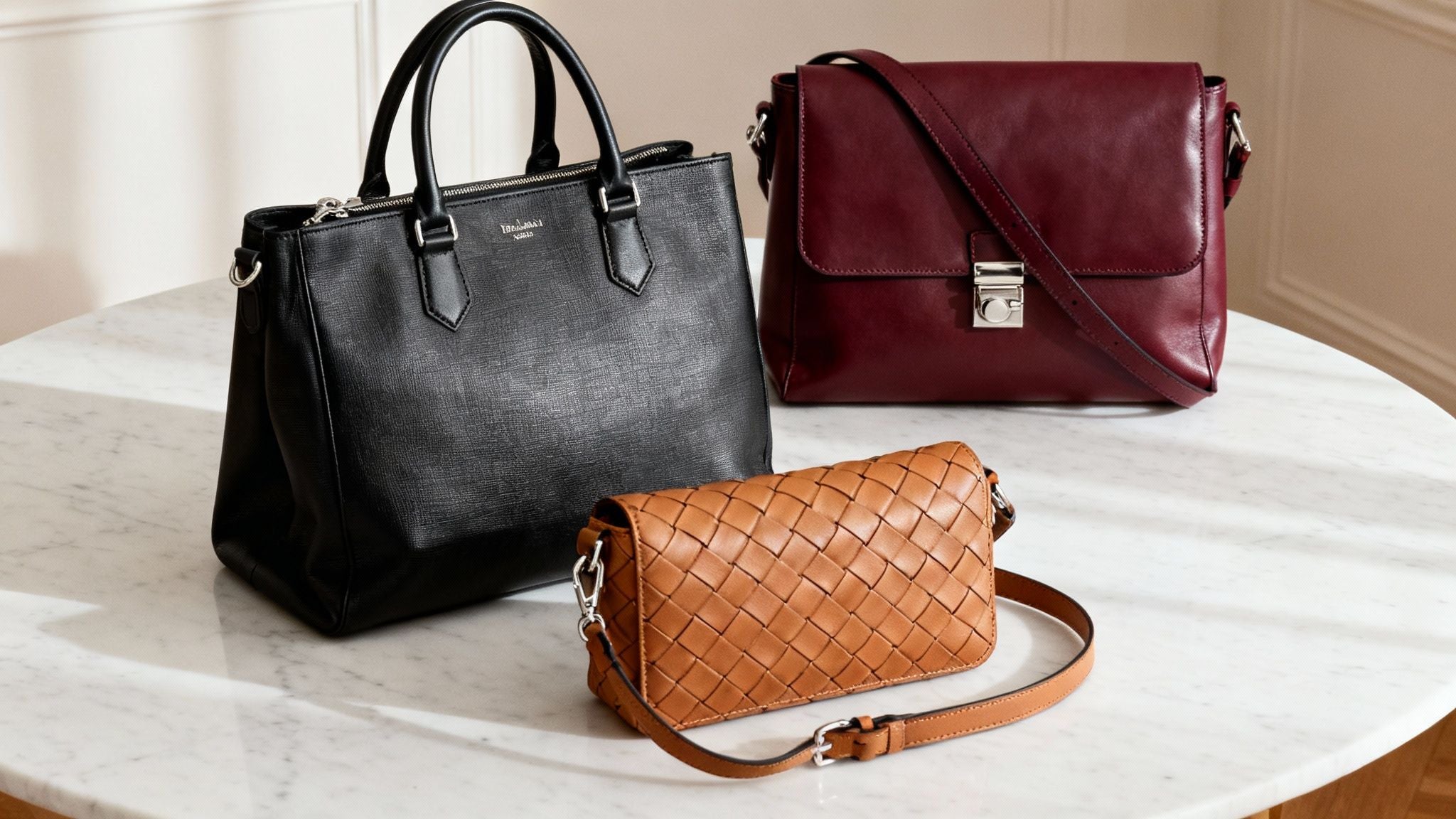Finding the Best Leather Conditioner for Handbags
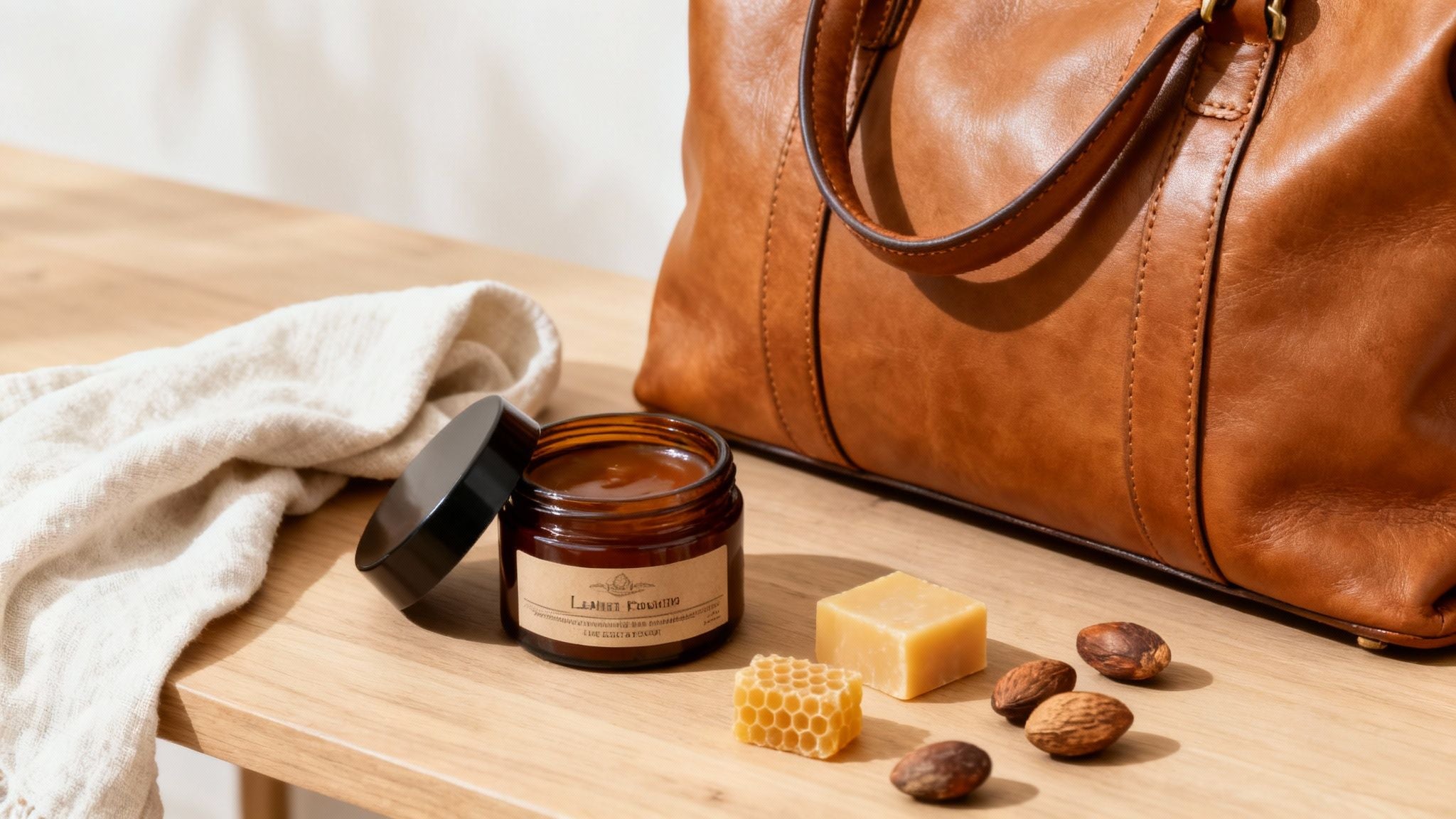
When you're searching for the best leather conditioner for handbags, it helps to think of it as a top-tier moisturizer for a treasured possession. It’s really all about preventative care—a small, smart investment to protect a much larger one by keeping your bag’s leather soft, supple, and safe from cracks.
Why Your Handbag Needs a Leather Conditioner
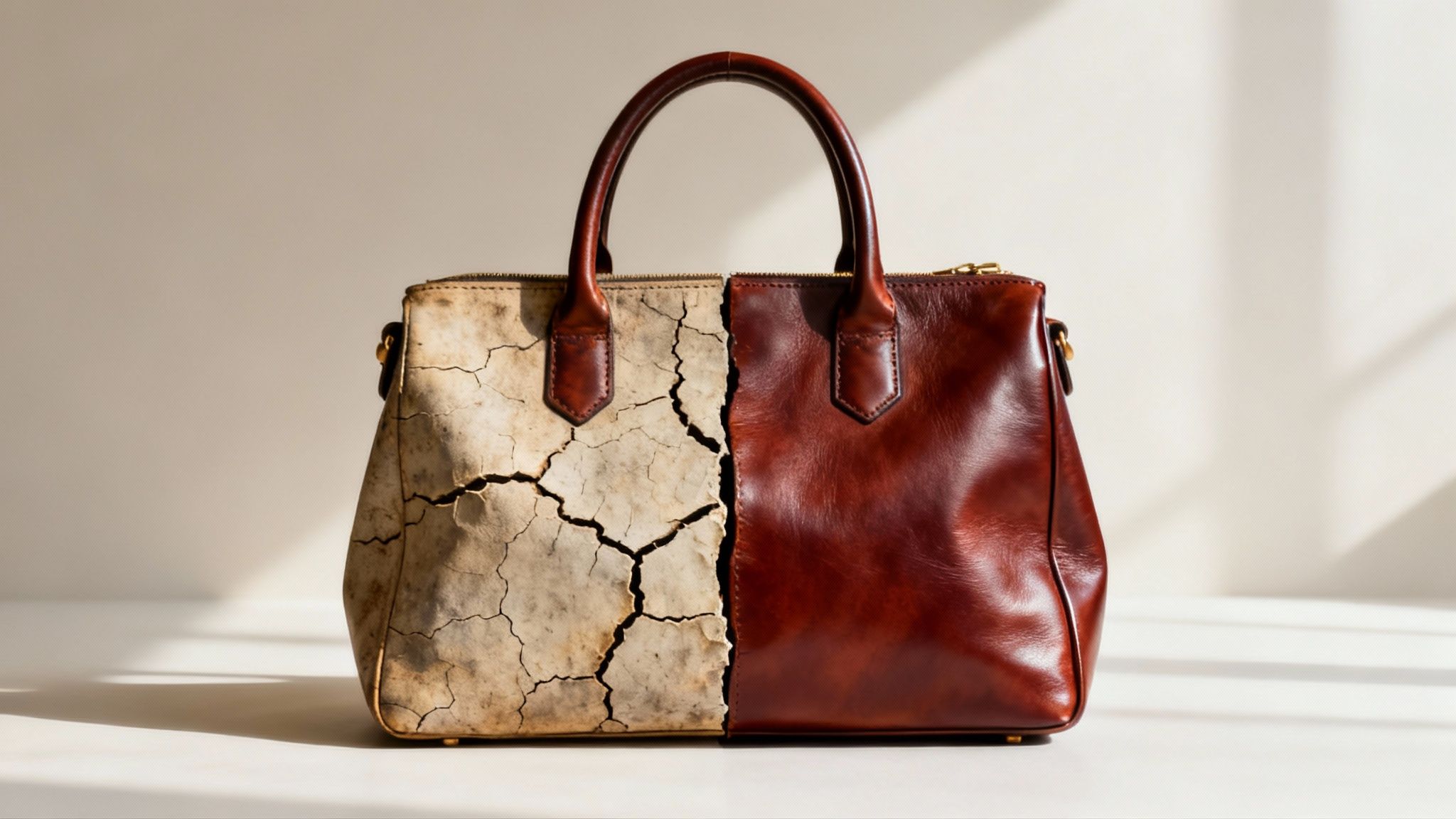
Picture your favorite leather handbag as if it were living skin. Just like our skin, leather is a natural material full of oils that keep it flexible and looking its best. But over time, things like sunlight, dry air, and even just daily handling can strip those essential oils away, leaving the fibers brittle and thirsty.
This loss of moisture is the number one enemy of leather. Without those oils, the material starts to stiffen up, the color can fade, and eventually, fine lines and cracks begin to appear, especially around the handles and seams where there’s the most stress. A quality conditioner gets deep into the leather’s pores to put that moisture back, nourishing it from the inside out.
The Science of Preservation
The idea is simple, but the results are incredible. A good conditioner goes to work to:
- Rehydrate the Fibers: It sinks in to restore moisture, bringing back that soft, pliable texture we all love.
- Prevent Cracking: By keeping the leather flexible, it stops cracks from forming when the bag gets bent or used.
- Enhance Color Richness: Conditioning often deepens and brings life back to the bag’s original color, which can look dull when the leather is dehydrated.
- Provide a Protective Barrier: Many formulas also leave behind a light, non-greasy barrier that helps shield the surface from minor spills and dust.
A well-conditioned handbag doesn't just look better; it holds its value for a whole lot longer. Regular care is the single most important thing you can do to preserve a leather accessory for years, or even decades.
Protecting Your Investment
With the global leather handbags market expected to jump from USD 2.61 million in 2024 to USD 3.89 million by 2032, it’s obvious these bags are more than just accessories—they're real investments. Taking care of them properly ensures your beautiful piece remains a timeless part of your collection.
This goes for all high-quality leather goods, of course. The same logic of regular conditioning applies to other items you use often, like when you're caring for a genuine leather wallet, to keep it looking great. To get more specific on maintenance routines, check out our guide on how to care for leather bags for more expert tips.
Decoding Conditioner Ingredients and Formulas
Trying to pick a leather conditioner can feel like you’re reading a foreign language. The label is usually a jumble of chemical names and confusing terms, making it almost impossible to know what you’re actually putting on your beloved handbag.
But it’s simpler than it looks. It all comes down to knowing which ingredients will genuinely nourish your bag and which ones will cause damage over time.
Think of the best leather conditioner as a healthy, balanced meal for your handbag. You’re looking for natural, wholesome ingredients that replenish and strengthen the leather’s fibers—not synthetic fillers that give you a quick shine but offer zero long-term benefits. A quality formula works with the leather, not against it.
The Good Stuff: Nourishing Ingredients
The most effective conditioners I’ve seen always use a thoughtful blend of natural oils and waxes. These ingredients are fantastic because they mimic the original fats found in the leather hide, allowing them to soak in deep and restore moisture right where it’s needed most.
Here are the key players to look for on the label:
- Natural Oils: Ingredients like neatsfoot oil, lanolin, and various seed oils (think coconut or safflower) are your best friends. They’re easily absorbed by the leather fibers, bringing back that beautiful flexibility and stopping the material from getting dry and brittle.
- Waxes: Beeswax and carnauba wax are great for creating a light, breathable barrier on the surface. This thin protective layer helps repel water and dust without sealing up the leather’s pores, which is absolutely crucial for keeping it healthy.
A well-balanced formula will almost always combine both. The oils get to work conditioning from the inside out, while the waxes provide that essential surface protection. It’s the perfect one-two punch for comprehensive care.
The Bad Stuff: Ingredients to Avoid
Just as important as knowing what to look for is knowing what to stay away from. Some chemicals can give your bag a temporary, glossy look but will slowly ruin it by drying out the leather or preventing it from breathing properly.
Steer clear of products that list petroleum distillates, certain silicones, and harsh solvents. These ingredients can strip away the leather’s natural oils or create a plastic-like seal that traps moisture inside, which can eventually lead to rot or cracking.
These additives might make a bag look amazing for a day, but they essentially suffocate the material. Over time, this leads to a dry, stiff surface that’s even more likely to get damaged than it was before. Always, always choose formulas that put the long-term health of your leather first.
Your Go-To Ingredient Guide
To make your search a little easier, I’ve put together a quick cheat sheet to help you vet any product you’re considering.
Leather Conditioner Ingredient Cheat Sheet
| Ingredient Type | Examples | Purpose / Why It's Good | What to Avoid / Potential Issues |
|---|---|---|---|
| Oils | Lanolin, Neatsfoot Oil, Coconut Oil | Deeply penetrates and replenishes natural moisture, keeping leather fibers flexible and supple. | Petroleum distillates, Mineral Oil |
| Waxes | Beeswax, Carnauba Wax | Creates a breathable, protective barrier against water and dust without clogging pores. | Heavy silicones, Paraffin wax |
| Cleaners | Glycerin, Mild Castile Soap | Gently lifts dirt from the pores without stripping essential oils from the leather. | Harsh detergents, Alcohols, Acetone |
| Emollients | Cocoa Butter, Shea Butter | Softens and nourishes the leather, enhancing its texture and rich feel. | Synthetic polymers that seal the surface |
Keep this guide handy when you’re shopping, and you’ll be able to confidently pick a conditioner that keeps your handbags looking incredible for years to come.
Matching the Conditioner to Your Handbag's Leather
Let's be clear: there's no such thing as a one-size-fits-all best leather conditioner for handbags. Picking the wrong formula for a specific type of leather is a lot like using a heavy, oily moisturizer on delicate skin—it can clog pores, leave a greasy film, or worse, cause permanent discoloration.
Every leather has its own unique personality. A rugged, full-grain leather tote bag is built very differently than a buttery-soft lambskin clutch. The tote can handle a richer, wax-based conditioner that adds serious protection, while the delicate clutch needs a lightweight cream that nourishes gently without weighing it down. This is exactly why figuring out your handbag’s leather type is the most important first step.
Know Your Leather Type
Before you even think about applying a conditioner, take a moment to understand the material you're working with. Different leathers have distinct qualities that determine the kind of care they need to look their best.
- Finished Leathers (like Nappa or Saffiano): These leathers are popular for a reason. They have a protective topcoat that makes them smooth and more resistant to spills and stains. They do best with cream-based conditioners that clean and moisturize without being overly heavy.
- Unfinished or Aniline Leathers: Known for being incredibly soft and absorbent, these leathers don't have that heavy protective layer. This means they require a very gentle, pH-balanced conditioner, usually a liquid or a very light cream, to prevent dark spots from forming.
- Suede or Nubuck: These are in a class of their own with that napped, velvety feel. They need conditioners made specifically for suede, because traditional creams or oils will instantly ruin that unique texture by matting down the fibers.
Choosing the Right Formula
Once you know your leather, picking the right conditioner becomes much easier. The goal is simple: give your bag exactly what it needs to thrive.
For the most common handbag leathers—think nappa, pebbled, or saffiano—a high-quality cream or lotion conditioner is your safest and most reliable choice. These formulas are perfectly balanced to add moisture and a light protective barrier without leaving a sticky residue or changing the leather's natural look.
On the other hand, if you have a more rugged, untreated leather bag, a wax-based conditioner (often made with beeswax or carnauba wax) can offer far better protection from the elements. These are fantastic for bags that get a lot of daily use and have to stand up to a little more wear and tear.
The cardinal rule of conditioning is to always do a spot test. Before you go all in, apply a tiny amount of the product to a hidden spot—like an inside flap or seam. Let it dry for a full 24 hours to be absolutely sure it doesn’t cause any unwanted changes in color or texture.
This careful, tailored approach isn't just for handbags, either. The same principles apply to any fine leather goods. For instance, knowing the specific material used for luxury leather strap watches is just as crucial for keeping them in pristine condition. When you match the product to the material, you ensure every leather accessory you own gets the exact care it deserves.
Conditioner Guide for Common Handbag Leathers
To make it even simpler, we've put together a quick guide to help you match the right conditioner type to some of the most popular handbag leathers. Think of this as your cheat sheet for perfect leather care.
| Leather Type | Key Characteristics | Best Conditioner Type (Cream, Oil, Wax) | Application Tip |
|---|---|---|---|
| Nappa Leather | Smooth, soft, semi-aniline finish. | Cream or Lotion | Apply a thin, even layer. Nappa is fairly durable but doesn't need heavy oils. |
| Saffiano Leather | Cross-hatch texture, very durable and water-resistant. | Cream | Focus on cleaning and light conditioning. The coating does most of the protective work. |
| Pebbled Leather | Textured, supple, and hides scratches well. | Cream or Lotion | Use a soft cloth to work the conditioner into the valleys of the pebble texture. |
| Lambskin Leather | Extremely soft, delicate, and prone to scratches. | Light Cream | Use a very small amount and apply with gentle, circular motions to avoid stretching. |
| Aniline Leather | Natural, porous, and absorbent. Shows scratches easily. | pH-Balanced Liquid or Light Cream | Test in a very hidden spot first! Apply sparingly as it darkens easily. |
| Suede/Nubuck | Napped, velvety texture. | Specialized Suede Conditioner (Spray) | Never use creams or oils. A specialty spray and a suede brush are essential. |
Remember, this table is a starting point. Always defer to the manufacturer's care instructions if they are available, and never, ever skip the spot test
A Step-By-Step Guide to Conditioning Your Handbag
Choosing the right conditioner is half the battle, but applying it correctly is where the magic really happens. Think of it as a spa day for your beloved bag—a gentle, methodical process that brings back its glow. With the right touch, you can get a truly professional finish right at home, reviving the leather’s natural beauty and protecting your investment for years to come.
First things first: always start with a clean slate. You wouldn’t put moisturizer on a dirty face, right? Before you even think about opening that bottle of conditioner, give your handbag a gentle wipe-down with a clean, soft, dry cloth. This gets rid of any surface dust or dirt, making sure you aren't trapping grime in the leather’s pores. For a deeper clean, our guide on how to clean leather purses is a great place to start.
This handy infographic breaks down exactly how to match the right conditioner to your bag before you begin.
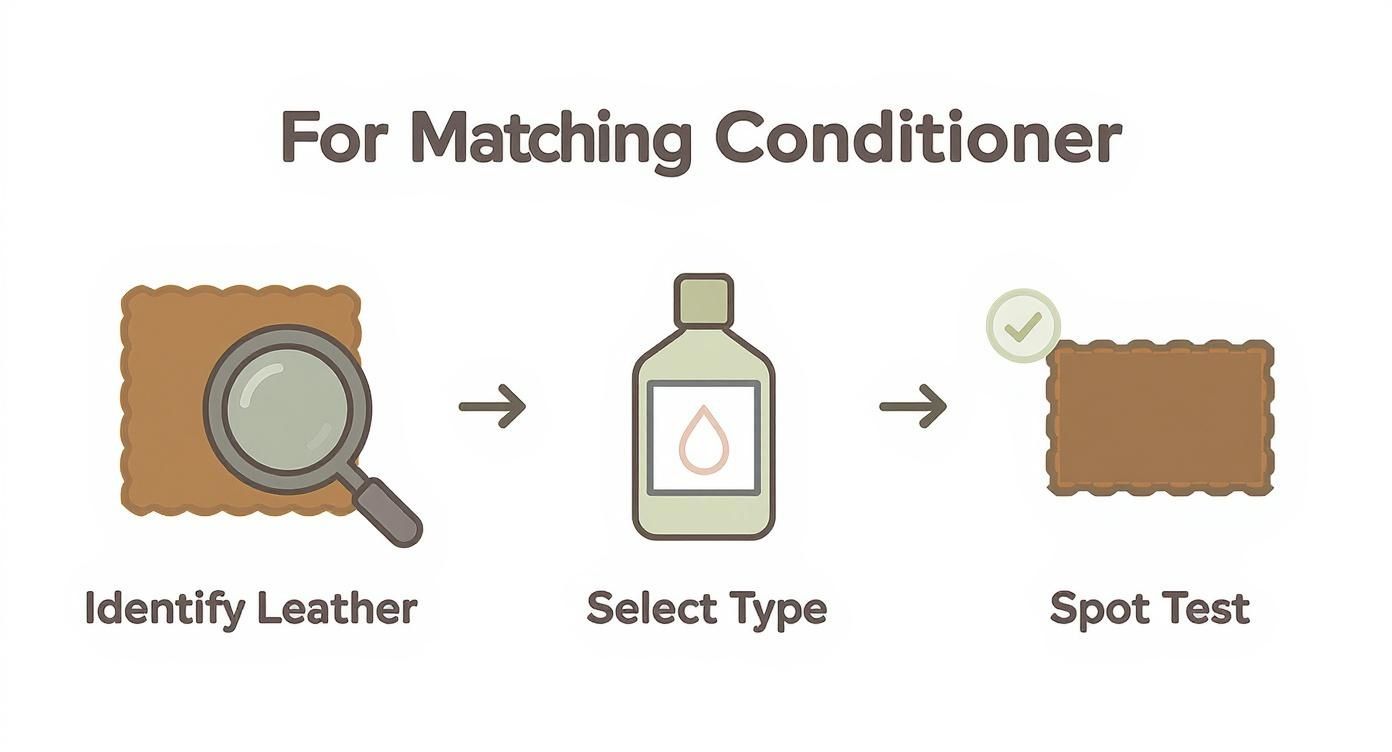
Nailing these three steps—knowing your leather, picking the right formula, and doing a quick spot test—is the secret to keeping your handbag safe and looking its best.
The Conditioning Process
Once your bag is clean and your product has passed the spot test, you’re ready to go. The golden rule here is that a little goes a long way. You want to nourish the leather, not drown it!
-
Apply a Small Amount: Put a small, dime-sized dollop of conditioner onto a clean, lint-free microfiber cloth. Never apply it directly to the handbag, as this can leave a dark, concentrated spot that’s tough to blend out.
-
Use Gentle, Circular Motions: Start on one of the main panels and gently massage the conditioner into the leather with soft, circular motions. This technique ensures you get even coverage and helps the product sink into the pores without stressing the material.
-
Address All Areas Evenly: Work your way across the entire bag in sections. Don't forget the straps, the areas around the hardware, and the corners. Use the same light pressure everywhere to get a consistent, beautiful finish.
-
Allow Time for Absorption: After you’ve applied a thin, even coat, let the handbag sit for at least 30 minutes to an hour. This downtime is crucial—it gives the nourishing oils and waxes time to fully absorb into the leather fibers.
-
Buff to a Natural Sheen: Grab a second clean, dry cloth and gently buff the entire surface. This final step whisks away any excess product and brings out a gorgeous, natural luster, leaving it looking healthy and supple, not shiny or greasy.
Pro Tip: It's much better to condition your bag lightly and regularly than to apply a heavy coat once in a blue moon. For bags you use daily, aim for a conditioning treatment every three to six months to keep them perfectly hydrated and protected.
This kind of careful maintenance is more important than ever. The luxury handbags market is set to explode, growing from USD 35.83 billion in 2025 to USD 60.42 billion by 2034. As we all invest more in these beautiful pieces, using the best leather conditioner for handbags is non-negotiable for preserving their value and that exclusive, fresh-from-the-boutique finish. You can find more insights on the luxury handbag market on PrecedenceResearch.com.
Common Conditioning Mistakes and How to Avoid Them
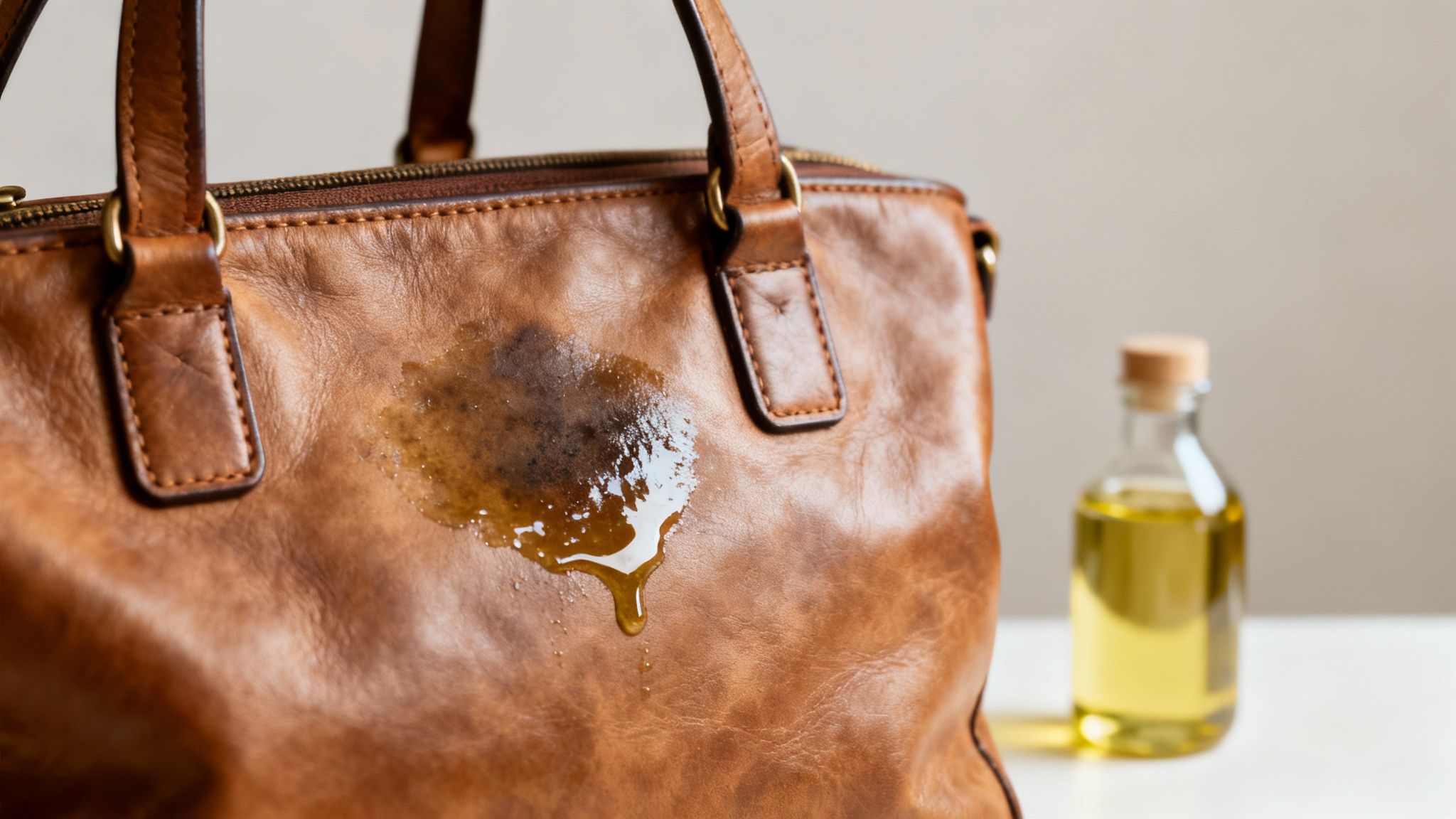
Even with the absolute best conditioner in hand, a few simple missteps can turn your loving care routine into a handbag disaster. Knowing what not to do is just as crucial as knowing the right steps. Steer clear of these common mistakes, and you’ll make sure your bag gets the nourishment it needs without any drama.
One of the biggest blunders is conditioning a dirty bag. Think of it this way: when you apply conditioner, you’re opening up the leather's pores to drink in moisture. If there's a layer of dust and grime on the surface, you're essentially massaging that dirt deep into the material, trapping it forever. Always, always start with a quick, gentle wipe-down.
The Over-Application Problem
More is definitely not better when it comes to leather care. It’s a very common mistake to slather on way too much conditioner, thinking it will offer some kind of super-protection. What really happens? You end up with a greasy, sticky film that actually attracts more dirt and dust.
Leather can only absorb so much product at one time. Anything extra just sits on top, dulling the finish and clogging the pores. Start with just a dime-sized amount on your cloth. A thin, even layer is all it takes to get that beautiful, healthy glow.
The goal of conditioning is to restore the leather's natural balance, not to saturate it. A light touch is the key to maintaining a supple feel and a healthy, subtle glow without creating a greasy mess.
Avoiding Damaging DIY Solutions
The internet is filled with so-called "hacks" for leather care, but trust me, many of them will cause permanent damage. Some of the worst offenders are everyday household items that should never, ever touch a quality handbag.
- Olive Oil or Cooking Oils: They might seem like a good idea, but these oils go rancid over time. This creates a foul smell and can permanently darken or stain your leather.
- Harsh Cleaners: Things like all-purpose cleaners, rubbing alcohol, or vinegar are far too aggressive. They will strip the leather of its essential oils, leading to brittleness, dryness, and cracking.
- Water: Trying to soak out a stain with water usually just makes it worse. You'll likely end up with an even bigger, more obvious water spot. For specific problems, you need targeted advice, like when you need to learn how to remove stains from leather the right way.
Proper handbag care is a huge part of owning luxury goods. With the global handbag market expected to hit USD 81.79 billion by 2030, people are investing serious money in quality pieces, making it more important than ever to use the right care products. By avoiding these simple mistakes, you'll keep your favorite accessory looking pristine for years to come.
Handbag Care Questions, Answered
Even with the best guide, a few specific questions always pop up. It's totally normal! Think of this section as your quick-reference for those little details that make all the difference in keeping your bag looking its best.
We'll clear up some of the most common handbag care mysteries so you can feel confident you're doing exactly what your bag needs.
How Often Should I Condition My Handbag?
There’s no single magic number here, as it really depends on your climate and how much you carry your bag. But a great rule of thumb is to condition your handbag every three to six months for regular use.
If you live somewhere very dry, the leather will get thirsty faster. In that case, you might want to treat it every two to three months. On the flip side, if you're in a humid environment, you can likely stretch that to every six to nine months. The best advice? Just look at your bag. If it's starting to seem a bit dull or feel stiff, it's telling you it’s time for some care.
Can One Conditioner Work for All My Leather Goods?
It’s tempting to grab one bottle for everything, but that's usually not the best idea. The leather on your rugged boots is very different from the delicate lambskin on your clutch, and they need different kinds of care.
For the absolute best results, it's always smart to match the conditioner to the specific type of leather.
- For Handbags: You want light creams or lotions that nourish the leather without leaving behind a heavy, greasy film.
- For Shoes/Boots: These can handle thicker, wax-based conditioners that also add a layer of water resistance.
- For Upholstery: Always use products made specifically for furniture to avoid making your couch feel slick or sticky.
Using the right product for the job ensures every piece you own gets exactly what it needs to stay beautiful for years to come.
If you’re building a care kit and want a versatile starting point for your handbag collection, a high-quality, pH-balanced cream conditioner is your best bet. It’s gentle enough for most common finished leathers like nappa, pebbled, and saffiano, making it a real workhorse.
What Is the Best Way to Handle Water Spots?
Getting caught in the rain can feel like a disaster, but a few water spots don't have to be a permanent problem. The key is to act quickly but gently. Whatever you do, don't just try to dry the spot itself—that will almost always leave a more noticeable ring.
Instead, grab a clean, soft cloth and dampen it slightly. Lightly blot the entire panel of the bag, from one seam to the other. This helps the moisture spread out evenly so the whole section dries uniformly, letting the original water spot just fade away. Then, let it air dry completely, far away from any direct heat source like a radiator or hairdryer.
Can Conditioner Fix Existing Scratches or Scuffs?
For minor scuffs and surface scratches, a good conditioner can be like magic. The oils and nourishing agents in the formula moisturize the leather fibers, which often darkens them just enough to help blend the scuff into the surrounding area. It really can make those little marks much less visible.
But it's also important to be realistic. Conditioner is for maintenance, not major surgery. If you're dealing with a deep gouge that has actually cut through the top layer of the leather, a conditioner won't be able to repair it. For that kind of damage, you’ll need to look into a specialized leather repair kit or consider taking it to a professional.
At The Bag Icon, we believe that luxury should be accessible and long-lasting. Explore our collection of beautifully crafted leather handbags and find the perfect piece to elevate your style. Visit us at The Bag Icon to discover your next favorite accessory.

